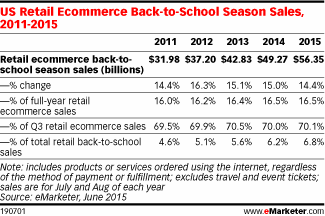As Fall slowly approaches, businesses start seeing red and green with the holiday season on the horizon. But won’t people please think of the children?
Back-to-school season – from elementary school to college – is in full swing, and it’s certainly not a time for online retailers to take a recess before class. In fact, performance during these first two months prior to the holiday selling season is a nice report card showing what’s going well and what can be improved. But let’s look at the chalkboard for some interesting ecommerce trends from last year, and what to expect in 2015.
Take notes
The National Retail Federation (NRF) released its back to-school and back-to-college surveys with a whole lunch of information on changing purchase habits, comparisons between school and college shopping, sought after products, and seasonal ecommerce spending to name only a few. Crack open the presentation below for some of the most important insights pulled from the surveys.
And if you aren’t convinced that back-to-school time is a legitimate season of ecommerce selling, eMarketer has some back-to-school retail statistics of their own for show and tell. From July to August alone, the market research firm is predicting a 14.4% growth in online retail sales that will end up accounting for 16.5% of total online retail sales for the entire year. But enough of the numbers, here’s for you visual learners:

Back-to-shipping
With the rise of ecommerce giants like eBay and Amazon, shipping has become a point of competition for consumer attention. Along with Wal-Mart, it’s reported that Target is offering free shipping in an effort to challenge Amazon. Consumers are increasingly going online to buy, and free shipping is a strong motivation to plug in those credit card digits into your online store’s payment portal.
Offering free shipping for customers is worth a thought, and implementing it during the back-to-school season is a solid practice test to view its effectiveness for the upcoming holiday season. It certainly doesn’t have to be free shipping on everything – you can choose to offer it on specific products, as well as orders at $35 and above, or any other threshold that works with your margins. Unlike middle school, you’re free to take a calculator out and do the math to figure out which of your products is a good selection for free shipping, as well as what order price point is the best fit for it.
The first day of school
Consider the back-to-school season as the first day of school; products need to be dressed to impress. And first impressions are especially important if you’re trying to keep a new customer coming back, as you should. When they hit the buy button, they already understand your price points and know of your site, so the next step is to burn your business into their brains like a nun forcing a student to write your company name on the chalkboard 40 times. And one of the best methods of doing so is through your packaging.
Customers already know the product that’s coming to their door, but it’s important to exceed, or at least meet, expectations. Product packaging is an excellent way to ‘wow’ a customer, or at least raise an eyebrow and create some sort of memory. Unpacking a product is just as important is wrapping it up, and it can definitely add to a customers overall experience. Below are some tips for ratcheting up your product packaging depending on method of fulfillment:
In-house:
Merchants with in-house fulfillment have as many options as a multiple choice question when it comes to product marketing, because it’s DIY. Feel free to add your own personal touches to the packaging, whether that’s logo-infused tissue paper or boxes, a custom-made thank you letter, or your standard business card. Another option is to include coupons or discounts to coax a customer into returning at a later date, i.e. the holiday period. You have complete control over your shipping and fulfillment, so take a timeout and build your branding.
Just-in-time:
Just-in-time fulfillment is essentially the same as in-house, but on a stricter deadline. You aren’t sitting on inventory, and you’re ordering and shipping off products as you make sales, but it’s always critical that you be punctual and on time to your customers’ doorstep, just like class. With all the extra space, consider stocking up on all the packaging you could possibly need. Although you’re purchasing products from vendors on the fly, it’s a good idea to do the opposite in regards to your packaging supplies. The second that product hits your HQ, wrap it up nicely, add your personalization, and ship it off before you’re tardy.
Dropshipping:
A dropshipping fulfillment method depends largely on your relationship with that specific channel. Your options are limited here, as you’ve basically signed up for a no-touching policy when it comes to shipping, but the possibility to add some personalization isn’t off the table. Consider checking in and probing for an opportunity to add a personal flair to your suppliers’ fulfillment process. Just raise your hand (or your phone) and ask a question to see if your channels are willing to work something out, whether it’s throwing in some business cards, or using custom packaging.
Outsourced:
With outsourced fulfillment, it’s along the same lines as dropshippers, but with slightly more leeway. You’re paying these guys to do your homework for you, but they may enjoy the money so much that they’re willing to add a little bit of personalization into their fulfillment process for you. Communication is everything here, so establish a good relationship that pleases both of you. If they’re a bully that feels they have more sway than you, consider looking into other warehouses that are prepared to allow for that small, personal touch.
Photo: Flickr, Dean Hochman



